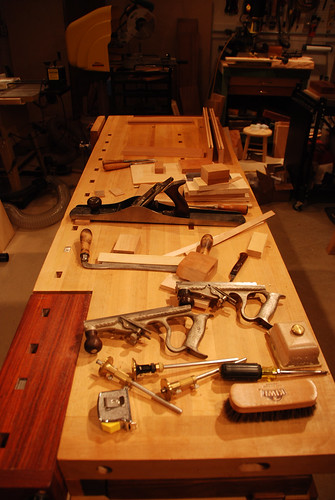
Originally Posted by
Clint Barden

Overall dimensions are appx 28" x 70"
I'm a "wide bench" guy, so I'm down with the width. I'm 6' with a high ape index and engage in general woodworking (mixed power and hand tools). I worked with a 32" (or was it 36"?) wide bench for about 4 years. Now I'm on a 25", and I'd like to get back a bit wider, 28-30. As for length, yeah, longer is better. 
I plan to put a steel vise on both corners, to allow clamping wide panels. I'm thinking a nice Jorgensen on the front side, and a cheaper one down the road on the far side.
Like others, I'd skip on the back-corner vise. That might be a good place though to put a square of dogholes for temporarily mounting a machinist's vise, something I've done.
The top will be made from 4/4 poplar. The stack of lumber I have to use is 1" x 5.5", so the main portion of the top will wind up being 2 3/8 - 2 1/2" thick. The aprons and endcaps will be 4 1/2" thick/wide. aprons are 2 boards (1 1/2" thick), endcaps are 4 boards (3" thick).
Skip the aprons, they're just heartache come clamping time. Make the entire top 3-4" thick.
When it comes time to cut/drill your dogholes, the spacing is fairly important. Space the holes that are lined up with the movable dog in your vise(s) at less than the throw of the completed vise, i.e.with whatever wooden jaws you use already installed.
With your trestle base, make sure that you have sufficient footroom no matter where you stand working on the bench.
I'll echo the suggestion to get Schwarz's book. It is the book about using and building workbenches. It's not as good of a coffee table book as some of the others, but you'll do some serious bench thinkin' after reading his book.
It came to pass...
"Curiosity is the ultimate power tool." - Roy Underhill
The road IS the destination.





 Reply With Quote
Reply With Quote

 The stack of poplar is ready and waiting.
The stack of poplar is ready and waiting.



